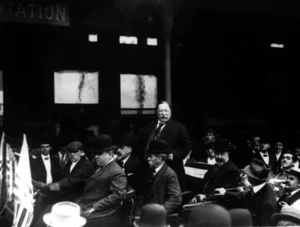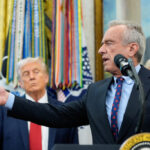
After the 1972 McGovern-Fraser Commission paved the pathway for the country’s modern primary system, presidential nominees have been, more or less, decided before parties’ national conventions. This election cycle, the Democratic Party’s drama over its nominee has once again opened debate over whether conventions should go back to their roots and pick nominees, or if they should remain the decorative coronation events they’ve become over the past half-century.
The journey to how modern voters pick presidential nominees has been long and raucous. In the earliest days of the republic, there was little need for a calculated nomination process. The Founding Fathers were already esteemed by the public and organically stepped into the presidency, so Hillsdale College politics professor Joseph Postell explained, “You really didn’t need to nominate those people. They were already distinguished on their own.” For over 50 years after America’s founding, the country generally used a caucus system.
The early 1830s marked the first significant change in parties’ nomination processes. In 1831, the Anti-Mason Party held the first national party convention. Although a minor third party, the Anti-Masons’ new tactic caught the eye of the country’s major political players. Without familiar faces such as George Washington and Thomas Jefferson, the young country was ready for a nomination process that could recruit and introduce new and unfamiliar candidates to voters.
In 1831, the National Republican Party held its own national convention, and the Democratic Party followed suit the next year.
The convention strategy used delegates to pick a winning nominee from a pool of competing candidates. It was an uncertain, dynamic process that often led to multiple rounds of voting as competitors jostled to gain favor with delegates and party bosses. In 1844, James Polk won the Democratic nomination only after the ninth ballot. At the 1860 Republican convention, Abraham Lincoln was not the favored candidate heading into the event — it was only after the third round that he won his party’s favor. Twenty years later, James Garfield clinched the GOP nomination after 36 rounds of voting.
Now called “open” or “brokered” conventions, delegates were not bound to any particular candidate headed into the event. Rather, they were free to vote for whichever candidate they favored. This political protocol for picking presidential nominees lasted well into the 20th century.
The open convention strategy was not without criticism. As Theodore Roosevelt challenged William Taft for the Republican nomination in the early 20th century, he protested the delegate model as anti-democratic. The smoke-filled rooms with big party bosses swaying delegates behind the scenes were not to his liking. As a leader of the Progressive Era, Roosevelt believed direct primaries best captured “the voice of the people” as Postell said.

“Roosevelt’s argument was, that [the convention model] is a betrayal of the people because the delegates often don’t speak for what the people actually want,” Postell said.
A staunch populist, Roosevelt believed that “if you really want to have democracy, you need to have the primaries choose who the delegates are going to support at the convention,” according to the political science professor. “That way, you really collect the voice of the people.”
Taft disagreed that direct primaries captured the heart of the republic. In 1913, he wrote a book called Popular Government, outlining why.
Taft argued in his book that “delegates had a sense of responsibility to pick more moderate candidates who could win and who would appeal to a broader number of voters, and so he thought that was the point of the party, was to build a big tent and have lots of different voters who can support the party,” Postell said.
While populists such as Roosevelt believed direct primaries allowed everybody to participate, Taft warned that in reality, the outcome would be far from democratic.
As Postell put it, “Somebody like you or me, we could never actually run for office. … We’d have to get the backing of all these donors. We’d have to go out and make a lot of speeches.”
Critics of the primary system warned it would be wealthy and connected people who bought and influenced their way into the nomination.
Postell called it a “weird paradox.”
“The more democratic you make your elections, the less democratic they actually become,” he said.

The bitter rivalry between Roosevelt and Taft proved to be a watershed moment in politics. Roosevelt may have lost the nomination, but he won the primary “war,” as the significance of the system was ingrained in the country’s political consciousness.
Unbound delegates and the open convention continued to exist until the 1970s, but after 1912, direct primaries began to play the dominant role in picking party nominees.
1968 proved to be the next pivotal point in the battle between open conventions and direct primaries. After then-Sen. Robert F. Kennedy was assassinated, multiple Democratic candidates hustled to clinch delegates at the convention. At the same time, violent protests put a pall over the event as Vietnam fervor hit a fever pitch. Although Vice President Hubert Humphrey, the establishment’s favored candidate, won after the first round, the atmosphere crackled with tension. By the end of the saga that capped off a decade of political violence, party leaders decided it was time to wrestle peace and order into conventions.
Out of 1968 came the McGovern-Fraser Commission, which launched the primary system as America knows it today.

In the years since the McGovern-Fraser Commission, both major political parties in the United States have adopted what are known as direct primaries. While historically, a victory in a primary was not a guarantee of the state’s delegates, in modern politics, that is no longer the case. The current nominating process in the U.S. mandates delegates be awarded based on results in primaries and caucuses.
In an article published by Teaching American History, political science professor Jeremy D. Bailey praised the move, saying it “democratized the nomination process, taking it away from the control of party leaders.”
However, after President Joe Biden dropped his reelection bid, some voiced support for taking the nomination process back to the open convention. From two dozen former House Democrats to Sen. Peter Welch (D-VT) and Washington Post columnist George Will, some voters hearkened to the old days, when delegates voters chose would select the best candidate.
As Welch said in a statement to the Associated Press, “Having it be open would strengthen whoever is the ultimate nominee.”
With Vice President Kamala Harris’s rapid ascension as Biden’s heir apparent, calls for an open convention have fallen on deaf ears.
While the modern primary system may have eliminated the old party-boss system and the deals that happened behind closed doors, Hillsdale history professor Paul Moreno said the breakdown of contested conventions only introduced a “different group of sort of power brokers in both parties.”
Other experts such as Jed Ober, the senior director of programs at Democracy International, disagree.
CLICK HERE TO READ MORE FROM THE WASHINGTON EXAMINER
“It strips elites of a key patronage tool and a great deal of influence in determining the intellectual trajectory of their party and — if they are successful — their country,” Ober wrote in 2015.
“In the long run, though, it strengthens the foundations and competitiveness of the party by expanding its constituent base to a more representative group of citizens,” Ober added.








